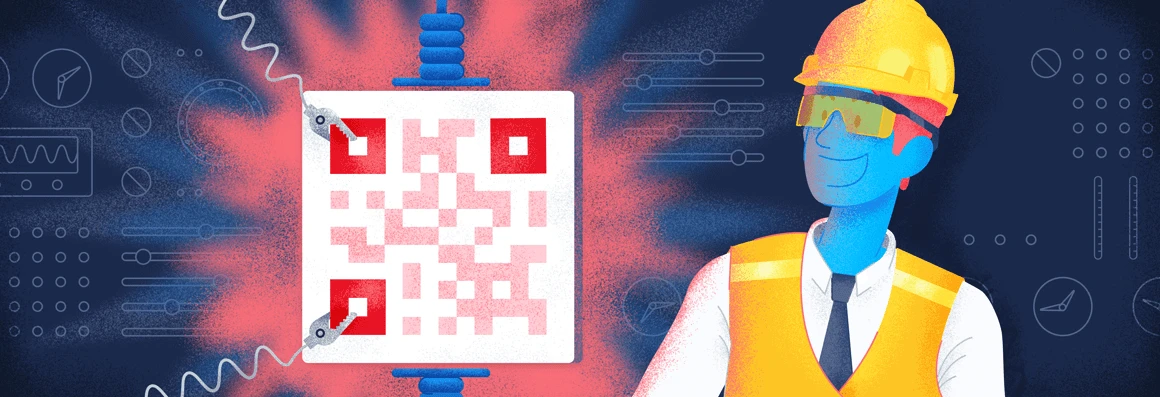- Best Practices ●
- COVID-19 ●
- Industry Trends ●
- Partners ●
- Product ●
6 Ways To Use QR Codes For Toy Manufacturing And Marketing
You’ve probably seen Quick Response (QR) Codes on everything from restaurant menus to marketing billboards. But you may not know that these black-and-white squares are also transforming industries like toy manufacturing.
QR Codes are essential for optimizing toy manufacturing processes like inventory management, quality control, and customer engagement. However, their usefulness doesn’t stop there!
Curious about how QR Codes can transform your toy business? Read on to learn six practical ways they can elevate your operations and boost sales.
*Note: The brands and examples discussed below were found during our online research for this article.
The rise of QR Codes in manufacturing
The days of manually ringing up items are long gone, replaced by the speed and convenience of 1D barcodes. While barcodes represent a significant improvement over tedious manual processes, they still have limitations—particularly when managing large inventories.
This is where the difference between QR Codes and barcodes becomes important.
QR Codes offer a more advanced solution for inventory management. Unlike Universal Product Codes (UPCs) on 1D barcodes (which have limited functionality and require exact alignment for scanning), QR Code labels can store thousands of characters and are scannable from any angle. This flexibility makes them ideal for modern manufacturing processes.
While QR Codes offer more flexibility than traditional 1D barcodes, there are two types manufacturers leverage, each with their specific applications: Static and Dynamic QR Codes.
Static codes cannot be tracked or edited once created, making them ideal for situations where information is unlikely to change. In manufacturing, you might use Static codes on machinery to link directly to an equipment manual via URL. You may also see them used near hazardous materials to link to Safety Data Sheets (SDS) or compliance information.
Dynamic codes are trackable and completely editable once created. You can change the code’s appearance, type, and destination at any time without affecting its functionality. These codes provide flexibility and data, so they’re well-suited for situations where the destination URL or code type may need to change periodically.
For example, a manufacturer may post QR Codes around the factory floor to share regularly updated training information. Because the URL will change every time the information is updated, a Dynamic code is the way to go. They’ll also provide insights into how employees engage with the codes, so management can see how many unique scans the codes get. This will give some context surrounding how many employees are reviewing the material.
3 ways to use QR Codes for toy manufacturing
Dynamic QR Codes offer transformative potential for toy manufacturers. Here are three must-know use cases for leveraging QR Codes for manufacturing to streamline your processes.
1. Inventory management
QR Codes can revolutionize how toy manufacturers manage inventory, significantly improving supply chain accuracy. When you add Dynamic QR Code labels to products and link them to your inventory management system, or IMS, or spreadsheet via URL, your team can easily scan the codes to open the product entry in the IMS and make updates as needed as the product moves from production to distribution. This way, your IMS is easy to update and enables management to see quickly which products are at which production stage.
But, the benefits extend beyond accuracy. Efficient inventory management increases productivity and cost savings across the supply chain. With QR Codes for inventory management, you can easily update stock levels, prevent overstocking or stockouts, and meet customer demand without delays.
2. Maintenance scheduling
Keeping equipment in top condition is essential for avoiding costly production delays and safety hazards. QR Codes can simplify the scheduling and management of maintenance activities.
Outfit key equipment—such as injection molding machines or assembly line conveyors—with a code so your team can instantly retrieve vital information with a QR Code scanner.
Each code can link to your asset management system via URL, so when a team member scans the code, the equipment’s entry pops up on their device. From there, they can access the equipment’s maintenance history, upcoming service dates, repair logs, and manufacturer guidelines. This helps ensure that maintenance is performed on time, minimizing the risk of unexpected breakdowns and keeping production on track.
3. Quality assurance
Ensuring toy safety is essential, and manufacturers are responsible for preventing hazards like choking risks, sharp edges, or loose parts.
QR Codes can significantly enhance your quality assurance process by providing instant access to important resources via URL like inspection checklists, testing protocols, and compliance documents. With 91 toy recalls reported last year due to various hazards, maintaining rigorous safety standards is more important than ever.
For toy manufacturers, including QR Codes on product packaging helps reinforce those standards, ensuring that safety protocols are followed and easily accessible to parents. This not only protects public health but also strengthens customer trust in your brand.
3 ways to use QR Codes for toy marketing
While QR Codes streamline toy manufacturing, their impact extends far beyond the production line. By using QR Codes for business growth and marketing, you can engage customers of all ages, provide essential product information, and gather valuable feedback to refine future products.
Here’s a closer look at how these codes can maximize your marketing efforts.
1. Engage customers with interactive content
These days, nine in 10 children have access to digital devices like tablets. While many still enjoy traditional toys, they increasingly gravitate toward digital games and experiences.
QR Codes can help you bridge the gap by creating hybrid play experiences that capture children’s attention and keep them entertained.
Take Baby Paws, for example. This Dalmatian plush toy comes with a QR Code that leads to a child-safe app, allowing kids to play with and care for their stuffed animal virtually. It makes playtime more interactive and adds an exciting digital layer to the user experience.
With QR Codes, you can easily update the linked content to keep kids engaged long after they’ve purchased the toy. It’s also a great way to introduce new releases and extend the lifespan of your products.
2. Share safety information via product packaging
Toy manufacturers have two primary audiences: children and their parents. While kids care about fun, parents are focused on toy safety. QR Codes can reassure parents by providing easy access to essential safety information.
By adding codes to your toy packaging, you can link parents to:
- Product information: Detailed safety warnings and guidelines for safe play.
- Instruction manuals: Simple, easy-to-follow instructions for assembly or use.
- Warranty info: Warranty details and registration options.
- Product updates: Information on recalls or updates.
Using smart packaging with QR Codes enhances transparency and improves the customer experience by giving parents peace of mind. This innovative approach ensures safety information is always within reach, building trust in your brand and encouraging long-term customer loyalty.
3. Uncover insights into your customers through feedback
Using QR Codes to gather customer feedback is another fantastic edge that old-school 1D barcodes can’t offer. Whether you include a Feedback QR Code sticker on your packaging or a thank-you note inside the box, you can encourage customers to leave reviews, share their experiences, and make suggestions for product improvement.
Here are some effective ways to use QR Codes for feedback:
- Reviews: Direct customers to share their honest thoughts with a Google Business Review QR Code.
- Social media: Boost customer engagement by encouraging them to follow and engage with your brand online using a Social Media QR Code.
- Surveys: Include quick surveys with Google Form QR Codes to gather detailed feedback on toy performance and features.
While positive reviews can strengthen your brand’s reputation, customer feedback is invaluable for improving your products. Understanding what resonates with your audience helps create toys that leave a lasting impression.
Streamline your toy manufacturing business with custom Dynamic QR Codes
If your toy company isn’t using Dynamic QR Codes yet, now is the time to start. QR Codes are a simple yet transformative tool for growing your business, from enhancing inventory management to boosting quality assurance to engaging customers with interactive content and beyond.
Of course, your strategy’s success starts with a reliable QR Code provider. QR Code Generator PRO makes it easy to create customized Static or Dynamic QR Codes to incorporate into your toy manufacturing business. These codes can help streamline everything from inventory management to quality assurance, and our Dynamic codes can give you powerful insights into how team members and customers engage with your products.
Get started with QR Code Generator PRO today to build fully customizable QR Codes that simplify inventory management and quality assurance, and boost customer engagement!






 Add custom colors, logos and frames.
Add custom colors, logos and frames.
